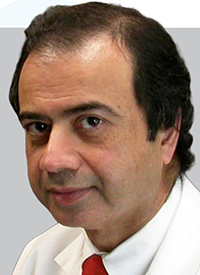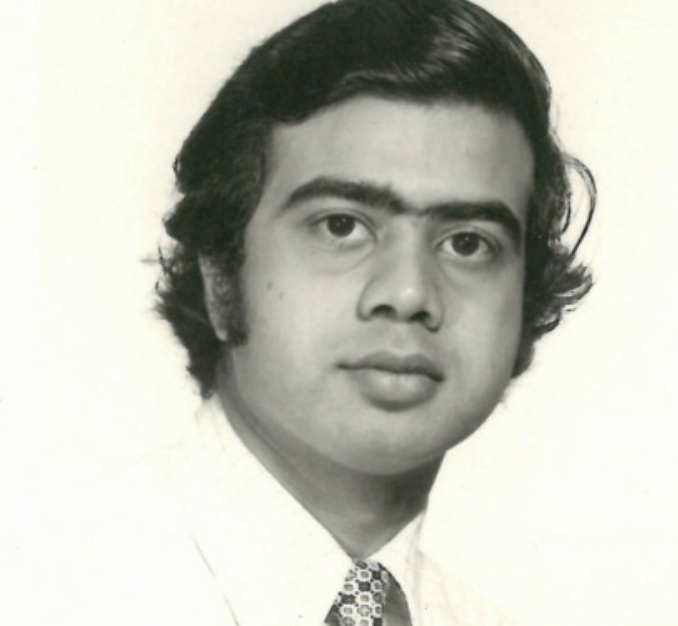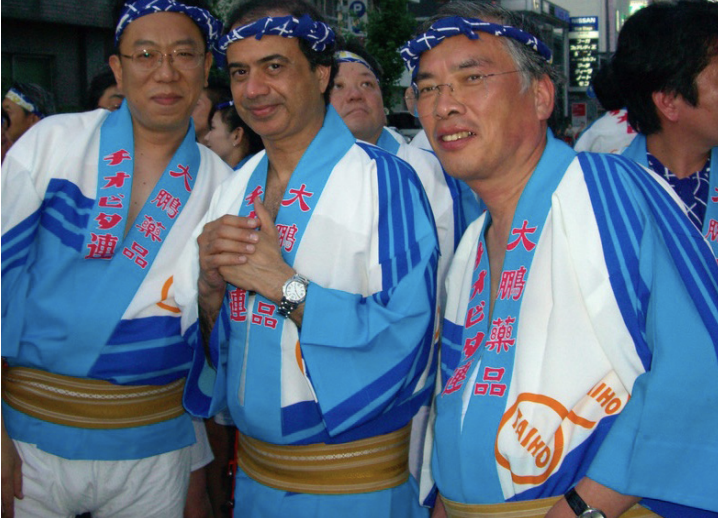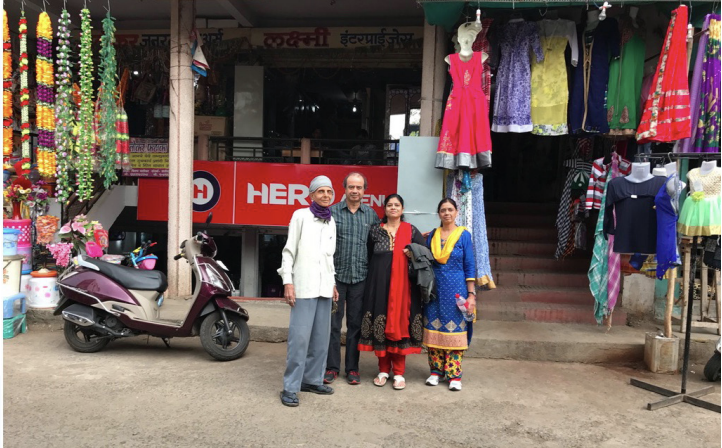The Desire to Always Do More
Jaffer A. Ajani, MD, has an unyielding drive that has resulted in breakthroughs in a deadly, but often overlooked, disease.
Jaffer A. Ajani, MD

At several key moments in a career spanning more than a half-century, Jaffer A. Ajani, MD, determined that the options available to him were simply insufficient. Whether yearning for more opportunity, more knowledge, or more research progress, this innate drive has propelled him from boyhood in a poor town in India to becoming one of the world’s top experts in gastric and esophageal cancers. He stands now at the pinnacle of his profession, with a resume that includes more than 700 peer-reviewed papers, but such success was far from guaranteed when he was growing up.
His parents had fourth-grade educations. His mother tended Ajani and his 5 siblings, while his father cobbled together a living running a shoe shop, selling mangoes and oranges from a sidewalk stall, or renting out a tiny fleet of hand-pulled rickshaw carts.
The cultural expectation was that Ajani would do the same, he said.
“I was raised to believe that you’re not supposed to leave the town where you were born. You’re supposed to do the family business. How can you leave your family?” he said in an interview from his office at The University of Texas MD Anderson Cancer Center in Houston.
Yet his father had a friend, a physician who made house calls on a motorbike. The young Ajani was entranced by this tall, striking man who zoomed from household to household and earned the respect of everyone in town.
At age 23, Ajani moved to the United States to begin work at a clinic in Altoona, Pennsylvania.

“For no other reason, I decided to become a doctor,” he said, laughing.
India was in desperate need of physicians when Ajani was young and the government heavily subsidized medical school fees, so even a poor man like his father could afford the tuition. Ajani left home for a city 35 miles away to begin his medical studies when he was just 17.
However, he eventually determined that while he could learn medicine there, he couldn’t actually practice it—at least not in the manner he had envisioned.
The struggling government hospital had a single electrocardiogram machine for 600 patients, and the time-consuming process to get authorization for use was absurd. Moreover, practicing medicine was often a pointless exercise. He had the tools and training to diagnose a child’s ear infection, for instance, and he could prescribe antibiotics, but he knew the parents could never afford the medicine.
“It was very painful,” he recalled. “It was very clear early on that there was no future for me there. I was looking for bigger things. I had to run from there.”
The Land of Opportunity
The United States beckoned as a place for a better future. In 1974, he accepted a clinical residency in Altoona, Pennsylvania, a small Rust Belt city in the Allegheny Mountains. Ajani grew up in the equatorial plains of central India where summer temperatures routinely hit 117˚ F. Now picture him, desperately homesick without a car, trudging to work through the snow during grim Northeastern winters. “Culture shock” barely begins to describe the experience.
Ajani with Jeff Netzer (tan suit), president of the Stupid Strong Foundation, and his laboratory team. The foundation has been a strong supporter of Ajani and his research over the years.

Making matters worse, Ajani had been advised to postpone his dream of going into orthopedics to pursue family medicine. The advice, while well intentioned, was a bad fit for him. He was on call every third night and found the work uninspiring.
In some ways, “it was a good experience,” he now concedes. “But in hindsight, I could’ve done without it.”
Turning his back on the chance to go into private practice in Altoona, he applied for an orthopedic surgery residence at Albert Einstein College of Medicine in New York, New York. At the interview, however, he discovered that all applicants had to train in general surgery first, with no guarantee of being allowed to specialize in orthopedics.
The gamble seemed too risky: What if he couldn’t pursue orthopedics after finishing his training? Instead, he contemplated what he’d enjoyed most about working as a family practitioner—the challenge of making a diagnosis—and switched to internal medicine.
Tulane University in New Orleans, Louisiana, offered him a residency, and there he got his first taste of oncology. He began in the field of cancers of the blood, but soon realized it simply wouldn’t be interesting enough for him. His teachers, although brilliant, spent their days bent over microscopes. He wanted to treat patients as well as research cancer cells.
“Scientific thinking about the disease was limited to how the cells looked under a microscope. The field has grown tremendously, but at the time, it was very boring,” he said. “I said to myself, ‘That’s not enough.’”
“That’s not enough.” The refrain once more drove his choices.
By 1980, just 6 years after arriving in Altoona, he had secured a fellowship at MD Anderson. He’d found his professional home. He was offered his choice of 2 slots: one in breast cancer and one in the gastrointestinal (GI) division. The breast cancer group was chock-a-block with veteran researchers; the GI division had just one.
“I thought, ‘This is a really good chance to see a lot of patients and do a lot of research,’” Ajani recalled of his decision to pick the GI position. He’s now a professor in the Department of Gastrointestinal Medical Oncology.
Soon he narrowed his focus even more, specializing in gastroesophageal cancers.
Slogging His Way to Breakthroughs
Gastroesophageal cancers are cruel diseases that have been painfully slow to relinquish their secrets. These can be treated effectively if caught early, but the symptoms are vague and often dismissed as minor irritants like heartburn or indigestion with or without weight loss.
Ajani with his then 4-month-old granddaughter, Maya.

Removing the entire esophagus is obviously not an option. Resecting part of the organ, then stretching stomach tissue into the chest, is a possibility, but that tactic is burdensome even when successful, said Crystal Denlinger, MD, senior scientific officer for the National Comprehensive Cancer Network (NCCN) and also a specialist in the esophageal cancer field.
“It’s a life-altering surgery. You’re never going to eat the same way,” Denlinger said. “And eating is underappreciated: Not only is it nourishment, but it’s also how you socialize with people, a way to take care of somebody.”
Gastroesophageal cancers affect about 46,000 Americans annually, but they are even more prevalent in Ajani’s native India, situated in the East Asian esophageal cancer “belt.” Furthermore, it is an orphan disease, and attracting research funds is an ongoing struggle.
Ajani with his daughter and son-in-law, Emilie and Cameron Howitt, and their daughter, Maya.

Nevertheless, Ajani spent much of the 1990s and early 2000s running a series of clinical trials for chemotherapy drugs administered in many different combinations with surgery and radiation. Progress, as measured by survival rate, was slow.
“For a very long time, our benefits were measured in weeks, not months,” said Denlinger.
“There have been times when I’ve been discouraged, and Jaffer was too. And we’ve slogged through,” said Wayne L. Hofstetter, MD, one of Ajani’s longtime research partners who is a professor in the Department of Thoracic and Cardiovascular Surgery and director of the Esophageal Surgery Program at MD Anderson.
However, very recently—just in the past 2 years— physicians have begun to see the needle move on treatment success. Ajani has served as a major investigator for 3 trials that have provided some much-needed bright spots.
Results from the phase 3 RATIONALE 302 trial showed that tislelizumab (BGB-A317), a novel humanized immunoglobulin G4 anti–PD-1 antibody, improved the rate of overall survival compared with chemotherapy as a second-line therapy. In September 2021, based on findings from RATIONALE 302, Novartis filed a biologics license application seeking FDA approval for tislelizumab in patients with people with advanced or metastatic esophageal squamous cell carcinoma who had received prior systemic therapy.
In 2020, Ajani served as one of the leading authors for the CheckMate 577 and 648 trials. Investigators took the novel approach of using a checkpoint inhibitor, nivolumab (Opdivo), as adjuvant therapy for patients with resected esophageal or gastroesophageal junction (GEJ) cancer who had previously received neoadjuvant chemoradiotherapy. Nivolumab doubled median disease-free survival compared with placebo (22.4 vs 11.0 months).
Based on these results, the FDA approved nivolumab in May 2021 for use in patients with completely resected esophageal or GEJ cancer with residual pathologic disease who had received neoadjuvant chemoradiotherapy.
CheckMate 577 “blew my socks off,” said Geoffrey Y. Ku, MD, an assistant attending physician at Memorial Sloan Kettering Cancer Center, speaking at the European Society for Medical Oncology Virtual Congress 2020. “It [was] absolutely a game-changer.”
The esophagus, a foot-long tube that would seem no more complex than a sausage casing, actually has cellular heterogeneity. Ajani and his associates recently found the same holds true for metastatic gastric tumors. By analyzing 45,000 individual tumor cells from 20 patients, they found 2 distinct cell subtypes, gastric-like and intestine-like, with the gastric-like cells much more aggressive. The team then developed a gene signature that could better predict patient survival.
These days, Ajani is most excited about the work that is the result of a decision he made years ago to begin collecting tissue samples from all his patients. It was originally suggested by a colleague, who convinced a skeptical Ajani to start the collection by telling him, “If you don’t do it, someone else will.” At the time, Ajani had no idea how he would ever use the samples. The hope is that the insights gained will lead to the production of individualized treatments. colleague, who convinced a skeptical Ajani to start the collection by telling him, “If you don’t do it, someone else will.” At the time, Ajani had no idea how he would ever use the samples.
Ajani at the 3-day Awa Odori Festival in Tokushima, Japan. He says the main dance is “fairly easy” for novices to learn.

The hope is that the insights gained will lead to the production of individualized treatments.
“Moving forward, we would like not to just try the next medicine on everybody,” Ajani said. “It has to be personalized, but it has to be on the basis of interrogation with a patient’s blood or tissue or something else.”
Outside the lab, Ajani’s efforts have helped secure a new pipeline of research funding for this oft-neglected cancer. His timing is good, unfortunately. Esophageal cancer is the eighth most common cancer and the sixth-leading cause of cancer death worldwide. Gastric cancer is the fourth most common cancer and third-leading cause of cancer-related deaths globally.
Ajani worked with patient advocacy groups to convince Congress to include gastric cancers among those for which the US Department of Defense allocates research funds. He even traveled to Capitol Hill to lobby legislators directly. That funding stream resulted in Ajani and his MD Anderson colleagues receiving roughly $10 million in grants since 2016.
Ajani with, from left: an older cousin; his sister-in-law, Laila; and youngest sister, Parveen; at a market in Katol, India.

Ajani serves as chair of the NCCN’s esophageal/ gastric cancers panels—the only chair the panel has had since its inception in 1997. He oversaw the drafting of new clinical practice guidelines in 2022.
Despite the behind-the-scenes procedural chores, Ajani said he relishes the panel’s meetings. He views them as his own personal continuing education seminars “You couldn’t learn more [anywhere else] in the couple of hours we spend [together] every few months,” he said.
Work Never Stops
Coworkers call Ajani by his first name (Jaffer rhymes with “suffer,” as he puts it) and describe a gentle man who almost never talks about himself. Denlinger, a member of the NCCN panel, calls him a careful listener who elicits opinions from everyone.
Trim and with a boyish face that belies his 71 years, Ajani says that if he’s in Houston, he’s likely in his office. Even on Saturdays and Sundays, he’ll go in for a few hours. On weekdays, he works “nonstop.” Hofstetter said his colleague doesn’t even pause to eat lunch, choosing instead to eat just 1 meal, dinner, each day.
Whenever he contemplates retirement, Ajani realizes he can’t leave right when the field is on the cusp of incredible breakthroughs. “He could have decided to retire 15 years ago,” Hofstetter said. “But he feels he still has work to do.”
Aside from his various clinical, research, administrative, and leadership duties, Ajani finds time to review submissions for nearly 3 dozen professional journals. Others might view this as a chore, but Ajani sees it as a way of getting a sneak peek at new research.
He also relishes doing his own writing. “I love to write. I don’t know where it came from,” he said. “But the things I love to write [most] are grants— you have to basically convince your peers that your idea is really good. I need to get better.”
He has a knack for catchy article titles. He published “It’s the poison that killed him, you say!” in 2003, and “Celebrate or calibrate? We say calibrate” came out in 2011, both in the Journal of Clinical Oncology.
If it sounds like Ajani has a lot on his plate, that’s what he prefers at this stage of his life. He does regret traveling as much as he did when his 2 daughters were little; he knows he missed a lot of their childhood milestones, but he found the travel “thrilling.”
“I think it was a mistake, but at the time I wasn’t smart enough to say no,” Ajani said.
At an age when he could begin to dial it back and take it easy, that isn’t happening. His mantra of “That’s not enough” applies to treatments as well. The man who left his homeland “looking for bigger things” wants that for his patients, too.
Jaffer’s dedication is legendary. Denlinger once accompanied him on a weeklong trip to Nigeria to discuss efforts to standardize treatment protocols for patients in sub-Saharan Africa. They spent their days discussing gastric cancer treatments, then met for informal dinners. Did he tell funny travel stories? Gossip about colleagues? Perform karaoke songs? No, Denlinger recalled. They talked about esophageal cancer
“He keeps saying, ‘We need to be thinking bigger,’ ” said Denlinger. “‘We need to be thinking more.’ ”



